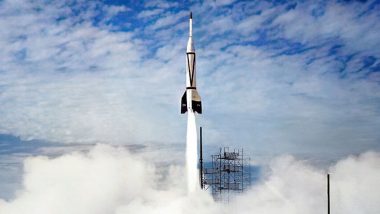New Delhi, August 9: China’s Long March 6A rocket broke apart creating over 300 pieces of trackable debris in low Earth orbit, after achieving a significant milestone of launching 18 Qianfan satellites, the US Space Command (USSPACECOM) said on Friday. The 18 satellites were part of the first batch aimed to establish China’s "own version of Elon Musk’s Starlink", called the Qianfan ("Thousand Sails") broadband network.
The satellites were launched on Tuesday on the Long March 6A rocket from the Taiyuan Satellite Launch Center in North China's Shanxi Province. The satellites were designed and built by the Chinese Academy of Sciences' Innovation Academy for Microsatellites in Shanghai. Sunita Williams, Barry Butch Wilmore May Remain Stuck in Space Till Next Year; NASA Plans To Bring Back Astronauts From ISS on SpaceX Dragon in February 2025 (Watch Video).
While the rocket successfully delivered the satellites at an altitude of about 800 kilometres, soon after its upper stage broke apart. The breakup generated a cloud of debris that is trackable around Earth, the USSPACECOM said. "USSPACECOM can confirm the breakup of a Long March 6A rocket launched on Aug. 6, 2024, resulting in over 300 pieces of trackable debris in low Earth orbit," the organisation said in a statement, posted on social media platform X.com on Friday.
"USSPACECOM has observed no immediate threats and continues to conduct routine conjunction assessments to support the safety and sustainability of the space domain," it added. China launched the Qianfan mega constellation project in 2023 to provide more extensive and high-quality communication services for domestic users.
Developed by the Shanghai-based company SpaceSail, the Qianfan network is reported to establish a network of over 15,000 low earth orbit (LEO) wide-screen multimedia satellites in the long run, of which 108 satellites will be launched this year and 648 satellites by 2025 end. Who Is Bindu Rani, Astrophysicist From India Exploring Black Holes at NASA?.
By 2027, the constellation aims to provide global network coverage, and ultimately by 2030, encompass 15,000 satellites providing integrated services such as direct mobile connections, Global Times reported. On the other hand, SpaceX's Starlink currently has more than 6,000 satellites in space and has more than 3 million customers in 100 countries.
(The above story first appeared on LatestLY on Aug 09, 2024 11:22 AM IST. For more news and updates on politics, world, sports, entertainment and lifestyle, log on to our website latestly.com).













 Quickly
Quickly












